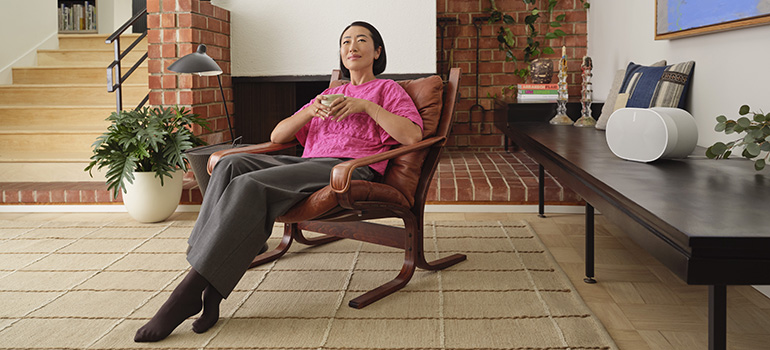 You have probably been hearing a lot about spatial audio recently. It is touted as a beneficial feature supported by everything from smart speakers from brands like Amazon, Apple, Google, and now Sonos, to headphone manufacturers, TV and music streaming services, and others. But, in layman’s terms, what is spatial audio?
You have probably been hearing a lot about spatial audio recently. It is touted as a beneficial feature supported by everything from smart speakers from brands like Amazon, Apple, Google, and now Sonos, to headphone manufacturers, TV and music streaming services, and others. But, in layman’s terms, what is spatial audio?
What is Spatial Audio?
Spatial audio is a technology designed to mimic the sound you would get from multiple speakers throughout a room, but through a single source. It’s effectively the replication of 360° immersive audio that is supposed to sound like you are listening to a multi-channel speaker system when you aren’t.
The term is often associated with Apple, but it can also be used interchangeably to describe any brand that incorporates or supports similar technology with its products. Sony, for example, calls its version of spatial audio, found in various headphones and supported through streaming services like Tidal, 360 Reality Audio. Then, of course, there’s Dolby Atmos and DTS:X, which effectively accomplish a similar end goal.
 The idea is that no matter where you’re sitting in a room, walking, or even as you move your head around, the sound follows. You hear it just as distinctly and crisply no matter where you are facing. This includes accurate and distinct separation of both left and right as well as up and down. If there’s a shooter coming from the left while you’re playing a video game, you’ll hear them just as though they are right in that very spot. Jets flying overhead in an action movie, meanwhile, seem so realistic, you feel the desire to look up and spot them.
The idea is that no matter where you’re sitting in a room, walking, or even as you move your head around, the sound follows. You hear it just as distinctly and crisply no matter where you are facing. This includes accurate and distinct separation of both left and right as well as up and down. If there’s a shooter coming from the left while you’re playing a video game, you’ll hear them just as though they are right in that very spot. Jets flying overhead in an action movie, meanwhile, seem so realistic, you feel the desire to look up and spot them.
Basically, spatial audio is a form of virtual surround sound just like Dolby Atmos and DTS:X. It promises to provide an immersive experience that is almost as good as, or some might argue is just as good as, actually having multiple speakers. But it uses different technology and mathematical and computing power to achieve the end goal.
How Does Spatial Audio Work?
Consider that when you have multiple speakers throughout a room, as sound comes from one, it travels to your ears and you hear it coming from where you should (i.e. where the speaker is placed that picks up that channel in the soundtrack). When wearing headphones or earbuds, you will, for the most part, hear sounds from the left in the left bud or earcup and sounds from the right in the right.

Apple AirPods
With spatial audio, advanced digital signal processing (DSP) works to create sound that is more immersive and enveloping. Each company describes its method a bit differently. Apple, for example, takes signals from sources like Dolby Atmos and applies directional audio filters to them, which in turn adjusts the frequencies so that you hear sounds differently, coming from all directions. When wearing compatible headphones, including several AirPods models and the Beats Fit Pro, Apple’s technology also includes head tracking. This allows for truly realistic sound. Other brands have their own version of head tracking technology, too, like Samsung with its 360 Audio and LG’s Tone Free earbuds that use Dolby Head Tracking technology.
Spatial audio only works, however, with content that is mixed for spatial audio. The good news is that this is becoming more widely available from a variety of streaming services, like Amazon Music Unlimited, Apple Music, and Tidal (using Sony’s 360 Reality Audio technology), among others. For home theatre, some top TV streaming services, like Netflix, also support spatial audio, with the highest tier subscription.

Sony wh1000xm4
With headphones that work with spatial audio technology, like the Sony WH1000XM4, HyperX Cloud Alpha Wireless Spatial Audio gaming headset, and Apple AirPods Max, head-related transfer function (HRTF) takes into account the size and position of the wearer’s head along with the anatomy of the ear and adjusts sound based on how these factors can impact sound waves. In most cases, depending on the model, you can personalize the sound using an app that will scan your ears and optimize the listening experience for you. The result will be different for every person.
Give it a Try
If you have a subscription to a music service that supports spatial audio, try it out. With Apple Music, for example, there’s an entire Spatial Audio category of tracks. Navigate to this and play a song in spatial audio than the same song without it. Even listening from the phone’s built-in speaker, you’ll hear a difference between the two.
You can also queue up a TV show or movie from a streaming service like Netflix and listen. Choose a title first with the Spatial Audio logo displayed then one without it.
But for the best and most accurate result, plug your phone into a pair of spatial audio headphones in a store or from a friend and queue up a playlist to hear for yourself.
Keep in mind that there’s a time and a place for listening to spatial audio. You might not find it to be the best option, or worth using, depending on how and where you listen.
Should You Care About Spatial Audio?
Spatial audio is not something that will make a huge difference or add tremendous value if you’re listening to tunes while going for your morning run, during short commutes to the office on a loud train, or while enjoying quiet background music at work.

Sonos Era 300
If you’re laying back with a good pair of hifi headphones and listening to a favourite music playlist, however, you may realize the benefits and find it worthwhile. For home theatre, if you’re watching a movie or sporting event or playing a video game that supports spatial audio, spatial audio can provide a deeply immersive experience without requiring a set-up that involves speakers in the front back, middle, and even above. You do, it should be noted, require the right subscriptions along with the right equipment.
Sonos is one of the latest companies to introduce a speaker with spatial audio, the Era 300. A set-up with two Sonos Era speakers in the back of a room, a Sonos Arc soundbar at the front, and a sub is designed to replicate the sound of a 7.1.4 Dolby Atmos set-up. The total cost would be under $3,500. But even though there are only three speakers and a sub, you hear sounds coming from overhead and every corner of the room as well.
 Spatial audio is a technology that you’ll want to visit a local audio/video shop and demo for yourself. Find music tracks you want to listen to from your favourite streaming service and add them to a personal demo playlist. Visit a store, try it out, and decide for yourself.
Spatial audio is a technology that you’ll want to visit a local audio/video shop and demo for yourself. Find music tracks you want to listen to from your favourite streaming service and add them to a personal demo playlist. Visit a store, try it out, and decide for yourself.


